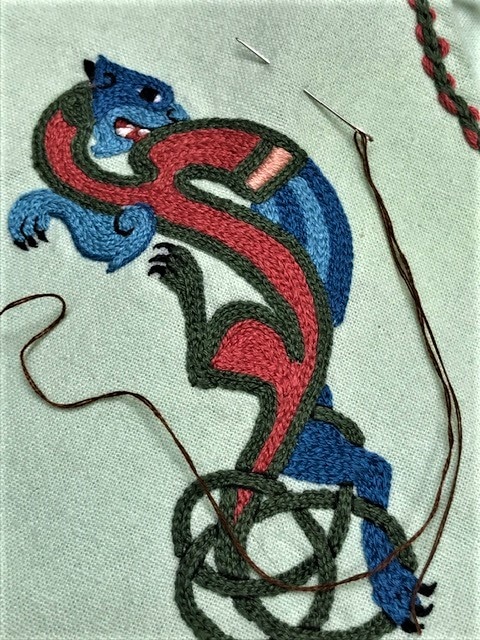
When one thinks of a shaman’s tools, objects like drums and staffs and rattles come to mind. And while I have used and do use such things, one of my favorite shamanic tools is a tiny #8 English sewing needle, bright and viciously sharp.
One of my earliest memories is of my maternal grandmother, a master seamstress, skillfully smocking a yellow lawn dress for my youngest cousin, weaving the thread back and forth through miniscule pleats to create the gathered honeycomb pattern adorning the yoke. She wore a sterling thimble, which I now prize, on her right middle finger, and her stitches were tiny, even and precise from decades of practice. Over the course of the years, I watched her hem wedding gowns, baste and tailor men’s suits, and mend socks with stitches so fine they left no tangible rib to annoy the wearer. Her skills created and adorned the debut and party gowns of many of Winston Salem’s foremost ladies.
Recently, while searching my sewing closet for fabric from which to sew Covid masks, I came across a cardboard packet which had been hers, bearing an image of several women dressed in gaudy mid-century print dresses sharing a sewing circle under the caption “Sewing Susan”. Within were a wide selection of hand needles, ranging from fine pointed Sharps to stout, blunt ended embroidery needles. The price on the cover was listed as 50 cents.
As an heir to my grandmother’s craft, throughout my life I’ve made clothing for myself and others and adore the art of fine embroidery. As a shaman, I find I often turn to the fiber arts to set spells and do my magical work. This, combined with my love of the past, led me to explore the history of the needle, perhaps one of our first and simplest tools, and yet significant to our survival as a species.
Until a recent archaeological find which included fragments of twisted fibers suggesting cordage, it had long been thought that our ancient Neanderthal ancestors wrapped simple hides and furs around themselves for warmth, whereas more modern hominids found that cutting and joining the hides for a closer fit kept them warmer. Most likely, found objects such as long thorns were initially used to pin the hides together. Next, thin strips of cut rawhide or sinew were pushed through holes poked with a sharp stone burin. But, ever observant about the resources in their world, our ancestors realized that long, thin splinters of bone were even stronger and could be used to pull strands of sinew or rawhide through holes strategically punched in the skins.
The oldest needle yet found dates to some 60,000 years ago. In ancient South Africa, someone splintered a hollow bird bone and ground a fragment of it to a point. Although it does not possess an eye, a groove at the distal end would have allowed cordage to be attached. In a cave in Eastern Slovenia, a bone needle dating to roughly 40,000 years ago was found, and bone and ivory needles found in the Liaoning province of China date to between 30,000 and 23,000 years ago. The first needle with an eyelet dates to this same period.
The method of construction remained the same: fresh or green bone, which is more brittle, was preferred, as were the shin bones of deer, goats and cattle, which broke readily into long splinters. Antler, although less brittle, is also tougher to carve and shape. A sharp flint burin was used to score the bone or antler lengthwise until a likely splinter could be excised. Further shaping with sharp flint tools and smoothing with fine sand on a piece of leather yielded a needle. No doubt many efforts were lost as the blank shattered while the eye was being carved or drilled.
Needles of bone or deer antler continued to be in use well into the Middle Ages. The more advanced iron-working technology of the Middle East produced needles more like our modern ones, although they were still very hard to make and shockingly expensive: in the 900s, a steel needle could cost a horse! These began to make their way to Western Europe through trade in the 800s and were so precious that a woman fortunate and affluent enough to own one likely wore it padded by a bit of lanolin-rich sheep’s wool in a bone or metal needle case suspended from her waist.
Needles and hand sewing continued to be the primary means of garment construction until the early Twentieth Century, when the foot-powered sewing machines developed by Isaac Merritt Singer became affordable enough to become more widely available. Singer built an empire on the backs of other inventors, making beautiful and simple machines that were powered by a treadle and used an up-and-down mechanism that cause a threaded and mounted steel needle to engage a second thread carried on a bobbin.
The act of hand sewing, and of embroidery in particular, always draws me to my connection with the Wyrd, the web of causality. As I stitch, my breathing deepens and regulates, my heart rate slows and I enter a lightly altered state of consciousness. I often pray as I sew, embedding my intent with careful stitches. I am grateful: to those ancient, innovative tool makers and to my Mother’s lineage who passed their skill to me. My gleaming point of steel pierces the linen, carrying magic and red floss, winding through history.